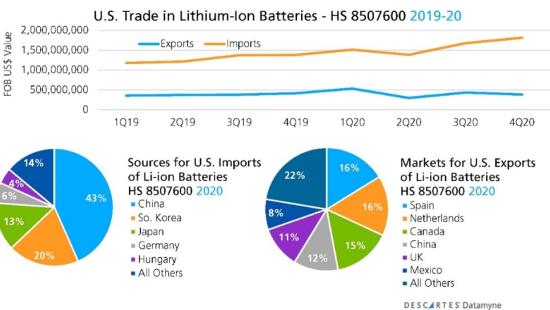With climate change a common topic of conversation these days, many people welcome the technological advances that are making electric vehicles (EV) a cost-effective alternative to traditional gas-fueled modes of transport. But according to global trade data, there are concerns about guaranteeing supplies of the metals needed to make the batteries.
These concerns come as President Biden ordered a review of critical supply chains, including those that fuel the electrification of transport along with semiconductors, pharmaceuticals, and strategic minerals. The aim was to strengthen the resiliency of U.S. supply chains to ensure that American economic and national security interests are not compromised.
The forecasts for EVs are rosy, especially as more governments are targeting zero-net emissions sooner than later. This includes the Biden Administration’s support for electrifying road transport. BloombergNEF, for instance, predicts that electric vehicle share of the global new car market will grow from 2.7% in 2020 to 10% in 2025 and 58% by 2040.
Supply the major roadblock to meeting demand
Lithium-ion batteries power most EVs today, but manufacturing them requires raw materials – in particular, cobalt, lithium, nickel and even graphite – available from only a few producers around the world. With demand rising, shortages are inevitable.
This is especially true when one country possesses more than its fair share of resources. Such as China’s control of the world’s supply of rare earth metals. Which makes President Biden’s supply chain resiliency initiative all the more important.
Diversifying supplier sourcing the key to supply chain resiliency
The United States imports most of its Lithium-Ion batteries, sourced mainly from China manufacturers, which made up 43% of shipments, followed by South Korea (20%), and Japan (13%), according to global trade data figures provided by Descartes Datamyne.
A key strategy to prevent supply chain disruptions, such as what the world experienced last year at the start of the coronavirus pandemic, is to diversify supply sources to include mineral-rich allies such as Canada and Australia, as well as develop domestic supply, even recycling the required materials. The business benefits to such a diversification strategy are threefold:
- Reducing the risk that comes with an over-reliance on one supplier;
- Getting the best ‘deals’ (for example, the U.S. import duty rate for lithium ion batteries manufactured in China is more than 10%, while for other suppliers it is 3.4% at most, or 0% with a free trade agreement); and
- Making the supply chain resilient to mass disruptions.
Looked at in this way, President Biden’s supply chain resiliency review makes sense at the national level and also at the corporate level.
Achieving Supplier Diversification
The best way to achieve rapid and effective supplier diversification is to be able to drill down into bills of lading and customs declaration data and search by country and HS code to find alternate suppliers, including company and contact details. Online solutions are available that allow businesses to tap into accurate and up-to-date global trade databases of major trading countries to make searching and analysis work fast and efficiently.
Other solutions required for effective supplier diversification include import compliance for HTS classification, duty, tariff data and landed cost calculation work, and denied party screening to help ensure that organizations do not enter into business dealings with so-called ‘bad actors’ named in international and domestic watchlists maintained by governments and world bodies.

